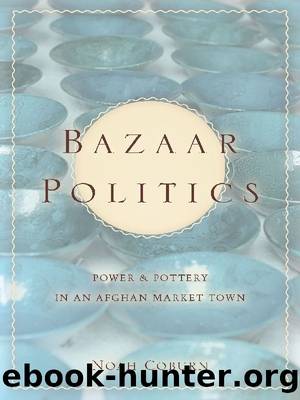Bazaar Politics by Coburn Noah

Author:Coburn, Noah.
Language: eng
Format: epub
Publisher: Stanford University Press
Published: 2011-10-15T00:00:00+00:00
THE DISTRICT GOVERNMENT
The main government representative in town was the district governor, whose office was in the crumbling, former hotel on the south hill of Istalif.18 As the chief representative of the government, he was technically in charge of most matters concerning the national government; for example, he was supposed to sign national identification cards. In reality, he delegated much of this work to maliks, who were far more familiar with the local population. (During my research period, the district governor was from Shekar Darrah, a town about half an hour south; he had arrived in town shortly before I did.)
Since the ability of commanders to threaten violence meant that the state did not have a monopoly on violence, most of the district governmentâs influence came not from its access to violence, but from its connections with Kabul. Beyond this, the district governorâs cultural, social, and economic capital were minimal. Despite having the key governmental position in town, his power was limited and poorly defined. For example, he claimed to resolve land disputes, but most people in town preferred to take such a dispute to their local malik first, or possibly to a mullah. Only if the dispute involved multiple, irreconcilable parties would the district governor be asked to intervene.19 Similarly, the government only became involved in disputes over rights to water access when the disagreement involved multiple districts.
The district governor himself was rarely visible in town. Unlike qaum elders or mullahs, he seldom appeared in the main mosque or walked through the bazaar. He lived in Kabul, came to town most days (but certainly not all), and usually remained in his office on the hill. The district governor had not been in town long, and this fit a general pattern in Afghanistan of rapid turnover among district officials.20 There was a sense of impermanence about the role of many officials, whom the national government often transferred to new districts. More visible in the life of the town was his administrative assistant, referred to by many as âthe engineer,â who did much of the day-to-day work of the district government.
Partially limiting the district governorâs role was the fact that he had few of the financial resources the state traditionally possessed. The complex system in which aid was distributed and allocated in post-Taliban Afghanistan restricted the district governorâs access to funds, and he did not have the redistributive powers that had created some patronage for government officials before the Soviet invasion. Much of the governmentâs development aid in Afghanistan was distributed through the National Solidarity Program (NSP). The NSP aimed to support local development and governance by dividing Afghanistan into twenty-five to three-hundred family blocks that elected their own councils. The councils then determined which public works projects would be carried out in the area.
The NSP existed under the Ministry of Rural Rehabilitation and Development, but it was managed by a group of NGOs. As a result, the largest single source of aid money in Istalif completely bypassed the district government.
Download
This site does not store any files on its server. We only index and link to content provided by other sites. Please contact the content providers to delete copyright contents if any and email us, we'll remove relevant links or contents immediately.
| Africa | Americas |
| Arctic & Antarctica | Asia |
| Australia & Oceania | Europe |
| Middle East | Russia |
| United States | World |
| Ancient Civilizations | Military |
| Historical Study & Educational Resources |
The Dawn of Everything by David Graeber & David Wengrow(1647)
The Bomber Mafia by Malcolm Gladwell(1583)
Facing the Mountain by Daniel James Brown(1503)
Submerged Prehistory by Benjamin Jonathan; & Clive Bonsall & Catriona Pickard & Anders Fischer(1419)
Wandering in Strange Lands by Morgan Jerkins(1372)
Tip Top by Bill James(1350)
Driving While Brown: Sheriff Joe Arpaio Versus the Latino Resistance by Terry Greene Sterling & Jude Joffe-Block(1338)
Evil Geniuses: The Unmaking of America: A Recent History by Kurt Andersen(1315)
Red Roulette : An Insider's Story of Wealth, Power, Corruption, and Vengeance in Today's China (9781982156176) by Shum Desmond(1313)
The Way of Fire and Ice: The Living Tradition of Norse Paganism by Ryan Smith(1303)
American Kompromat by Craig Unger(1268)
It Was All a Lie by Stuart Stevens;(1263)
F*cking History by The Captain(1253)
American Dreams by Unknown(1234)
Evil Geniuses by Kurt Andersen(1223)
Treasure Islands: Tax Havens and the Men who Stole the World by Nicholas Shaxson(1218)
White House Inc. by Dan Alexander(1176)
The First Conspiracy by Brad Meltzer & Josh Mensch(1139)
The Fifteen Biggest Lies about the Economy: And Everything Else the Right Doesn't Want You to Know about Taxes, Jobs, and Corporate America by Joshua Holland(1087)
